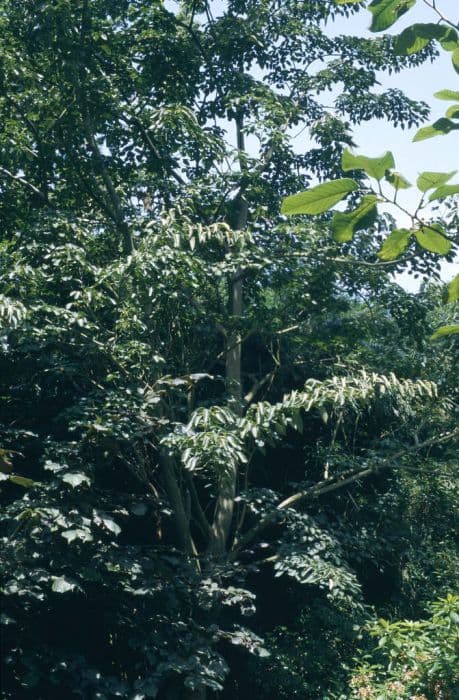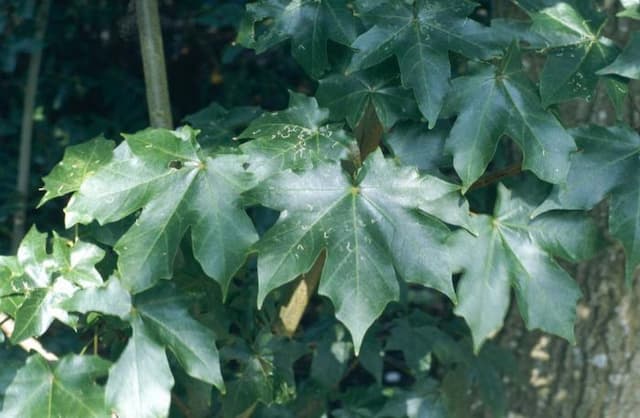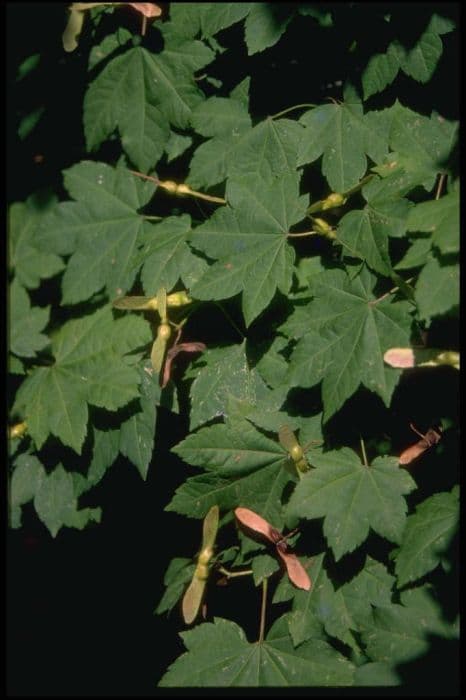Redvein Maple Acer rufinerve 'Albolimbatum' (v)

ABOUT
Acer rufinerve 'Albolimbatum', commonly known as the Grey-budded Snakebark Maple, is notable for its striking appearance. This ornamental tree presents a distinct and attractive variegated foliage, which is primarily where its aesthetic value lies. The leaves typically showcase a blend of green hues with beautiful creamy-white margins, creating a contrast that brings a visual freshness to any garden or landscape. Seasonal changes bring about transitions in the leaf color, often to striking shades of yellow or red, providing a dramatic display before the leaves fall. The bark of the Grey-budded Snakebark Maple is another point of interest; it is marked with vertical stripes that can add texture and a uniqueness to the trunk and branches, even in the winter months when the leaves are gone. Flowers and subsequent winged seeds (samaras) may appear on the tree, but these tend to be more subtle features compared to the pronounced characteristics of the foliage and bark. The branches tend to grow in an appealing, somewhat open habit, giving the plant an airy feel. In cultured landscapes, the intricate foliage patterns and distinctive bark texture make the Grey-budded Snakebark Maple a sought-after tree for adding visual interest, without taking up too much space due to its moderate growth habit. Overall, the plant's appearance can be characterized as elegant and eye-catching, with a vivid play of colors and patterns throughout the seasons.
About this plant
 Names
NamesFamily
Sapindaceae.
Synonyms
Redvein Maple, Grey-budded Snake-bark Maple, Honshū Maple, Variegated Redvein Maple.
Common names
Acer rufinerve 'Albolimbatum'
 Toxicity
ToxicityTo humans
The plant in question is commonly known as the Grey-budded Snakebark Maple. Generally, maples (Acer species) are not considered toxic to humans. There is no well-documented evidence of the Grey-budded Snakebark Maple causing poisoning when touched or ingested. However, it is always advisable to exercise caution and avoid ingesting plant parts that are not traditionally considered food, as individual reactions to plants can vary.
To pets
The Grey-budded Snakebark Maple is not known to be toxic to pets. Most members of the Acer genus are considered non-toxic to cats and dogs. However, as with humans, not all potential reactions can be anticipated, and it is always best to prevent pets from ingesting non-food plants. If a pet does consume part of a Grey-budded Snakebark Maple and shows signs of illness, contacting a veterinarian would be the recommended course of action.
 Characteristics
CharacteristicsLife cycle
Perennials
Foliage type
Deciduous
Color of leaves
Variegated
Flower color
Yellow
Height
20 feet (6 meters)
Spread
20 feet (6 meters)
Plant type
Tree
Hardiness zones
5
Native area
Japan
Benefits
 General Benefits
General Benefits- Aesthetic Appeal: The Acer rufinerve 'Albolimbatum', commonly known as Grey-Budded Snake-Bark Maple, enhances gardens with its variegated leaves and striking bark.
- Seasonal Interest: This plant provides year-round visual interest, with foliage that changes color in different seasons and distinctive winter bark.
- Habitat for Wildlife: It offers shelter and food to a variety of wildlife, such as birds and beneficial insects.
- Shade: It can create shaded areas in the landscape, providing a cool retreat during sunny days.
- Erosion Control: The root system helps stabilize soil and prevent erosion on slopes or banks.
- Drought Tolerance: Once established, it can be relatively drought-tolerant, reducing the need for frequent watering.
- Low Maintenance: The Grey-Budded Snake-Bark Maple typically requires minimal pruning and upkeep once established in the landscape.
 Medical Properties
Medical PropertiesThis plant is not used for medical purposes.
 Air-purifying Qualities
Air-purifying QualitiesThis plant is not specifically known for air purifying qualities.
 Other Uses
Other Uses- Acer rufinerve 'Albolimbatum', also known as Grey-barked maple, can be employed as a natural dye source. The leaves, when collected and processed, can impart a subtle green hue to textiles.
- The sap of Grey-barked maple can be used in small scale to produce maple syrup, although it's not as commonly tapped as Acer saccharum, the sugar maple.
- Woodworking projects can benefit from the use of Grey-barked maple wood, which is known for its fine grain and workability.
- The leaves, if dried and crushed, could potentially be used to stuff sachets to naturally deter pests in closets or drawers with their scent.
- Grey-barked maple can act as a host plant for various butterfly species, thereby supporting local biodiversity.
- With proper training and shaping, Grey-barked maple branches may be harvested for use in artistic endeavors like wreath making or as part of sculptural pieces.
- The tree can be incorporated into educational programs as an example of phenotypic plasticity due to its interesting leaf variegation, engaging students in botany studies.
- As a bonsai, Grey-barked maple offers enthusiasts a unique variety due to its distinct foliage and bark features, making it a standout miniature tree.
- Grey-barked maple wood can be used for smoking fish or meats, imparting a delicate flavor different from more traditional smoking woods.
- The tree's structural form and variegated foliage can be used in landscape photography to add texture and visual interest to natural scenes.
Interesting Facts
 Feng Shui
Feng ShuiThe Snakebark Maple is not used in Feng Shui practice.
 Zodiac Sign Compitability
Zodiac Sign CompitabilityThe Snakebark Maple is not used in astrology practice.
 Plant Symbolism
Plant Symbolism- Strength - The 'Albolimbatum' is a variety of maple (Acer genus), and maples commonly symbolize strength due to their hardy nature and sturdy wood.
- Longevity - Maples, with their potential for long life and enduring presence, often represent long life and endurance.
- Balance - The symmetrical leaf shape can be seen to symbolize balance and equanimity in one's life.
- Generosity - In some cultures, the abundant seeds of the maple signify generosity, as the tree shares its bounty freely with the world.
 Water
WaterFor the 'Striped Maple,' gradually water the plant to ensure the soil is moist but not waterlogged. During the growing season, water the tree once a week with about 1.5-2 gallons per session, depending on the tree's size and the weather conditions. Reduce watering in the fall and water sparingly in winter, only enough to prevent the soil from completely drying out. Adjust the amount and frequency based on rainfall and soil drainage to prevent water stress. Overhead watering is not necessary; instead, focus on the root zone.
 Light
LightThe 'Striped Maple' prefers a spot with dappled sunlight or partial shade, avoiding intense afternoon sun which can scorch the leaves. It thrives under the canopy of taller trees or on the north or east side of a building where it receives gentle morning light or filtered afternoon light. Adequate light is crucial for healthy foliage, but protection from harsh rays is equally important.
 Temperature
TemperatureThe 'Striped Maple' can withstand a broad range of temperatures, generally surviving minimum temperatures around -20 to -30°F and tolerating maximum temperatures up to 90°F. However, the ideal temperature range for this maple is between 50°F and 75°F, which encourages robust growth and attractive foliage. Extreme temperature fluctuations should be avoided to prevent stress on the tree.
 Pruning
PruningPrune the 'Striped Maple' primarily to remove any dead, damaged, or diseased branches, which helps maintain tree health and aesthetic appeal. Minimal pruning is best; prune in late winter or early spring when the tree is still dormant. Occasional thinning of the canopy can allow light and air to penetrate, promoting healthy growth. Avoid heavy pruning, as it is not necessary unless the tree is overgrown or structurally unbalanced.
 Cleaning
CleaningAs needed
 Soil
SoilThe Greenstripe Maple thrives in well-drained soil enriched with organic matter. A mix of loam, peat, and sand works well, ensuring acidity with a pH of 5.5 to 6.5.
 Repotting
RepottingThe Greenstripe Maple should be repotted every 2-3 years, more frequently when it's younger and growing more rapidly.
 Humidity & Misting
Humidity & MistingThe Greenstripe Maple prefers moderate humidity levels, avoiding extremely dry environments.
 Suitable locations
Suitable locationsIndoor
Place Greenstripe Maple in bright, indirect light, and keep soil consistently moist.
Outdoor
For Greenstripe Maple, choose partial shade and shelter from wind.
Hardiness zone
5-7 USDA
 Life cycle
Life cycleAcer rufinerve 'Albolimbatum', commonly known as Grey-Budded Snake-Bark Maple, begins its life as a seed, typically requiring exposure to a period of cold to break dormancy through stratification. Upon germination in the spring, the seedling establishes itself, gradually developing a distinctive smooth, olive-green bark streaked with white. Through its juvenile stage, it grows relatively quickly, forming a small tree with variegated leaves that are usually pink-tinged when young, turning to yellow or red in the fall. Reaching maturity after several years, the tree may flower and produce samaras, the winged seeds characteristic of maples; however, flowering is often irregular. As an adult, the Grey-Budded Snake-Bark Maple can enjoy a longevity of several decades, maintaining a moderate size with proper care and growing conditions. In its final stage, the tree will slow in growth, eventually becoming susceptible to environmental stresses or diseases which can lead to its decline and eventual death.
 Propogation
PropogationPropogation time
Spring-Early Summer
The Japanese maple 'Albolimbatum', a cultivar of Acer rufinerve, is commonly propagated through softwood cuttings taken in late spring or early summer. To do this, cut a 4 to 6-inch (about 10 to 15 centimeters) stem from new growth of the tree that has not yet hardened, ensuring it has several leaf nodes. Remove the leaves from the bottom half of the cutting and dip the cut end in rooting hormone to encourage root development. Then, plant the cutting in a moistened mix of equal parts peat and perlite, ensuring the leaf nodes where you removed leaves are buried. Place the container in a warm spot with indirect light and maintain consistent moisture. Roots typically develop within a few weeks, after which the cutting can be transplanted into individual pots to grow on until they are ready to be planted out into the garden.





![Freeman maple [Autumn Blaze]](/_next/image?url=https%3A%2F%2Fplants-admin.emdemapps.com%2Fimages%2Fplants%2F%2Fimages%2F604b575b84d87.png&w=640&q=75)



